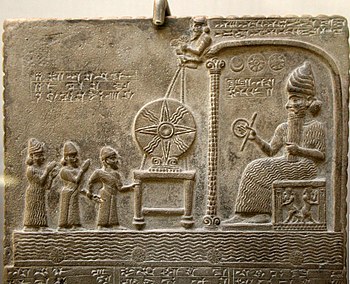Sun God Tablet

Tablet of Shamash
|
|
| Material | Limestone |
|---|---|
| Size | Length: 29.2 cm, Width: 17.8 cm |
| Created | 888-855 BC |
| Present location | British Museum, London. Room 55. |
| Registration | ME 91000 |
The Tablet of Shamash is a stone tablet recovered from the ancient Babylonian city of Sippar in southern Iraq in 1881; it is now a major piece in the British Museum's ancient Middle East collection. It is dated to the reign of King Nabu-apla-iddina ca. 888 – 855 BC.
The tablet was discovered during excavations by Hormuzd Rassam between 1878 and 1883. The tablet was found complete, but already broken into two large and six small pieces by the time of King Nabopolassar, between 625 and 605 BC. He replaced it with a new one and placed the original in an inscribed earthenware casket along with some related items and interred them under the asphalt temple floor.
It was encased in a clay cast or "squeeze" that created impressions when placed over the face of the stone and protected it. This indicates that the tablet was an item of reverence, possibly stored due to newer traditions. The tablet has serrated edges like a saw, which was the symbol of both Shamash and Saint Simon Zelotes in later tradition. The bas-relief on the top of the obverse (pictured) shows Shamash, the Sun God, beneath symbols of the Sun, Moon and star. The God is depicted in a seated position, wearing a horned headdress, holding the rod-and-ring symbol in his right hand. There is another large sun disk in front of him on an altar, suspended from above by two figures. Of the three other figures on the left, the central one is dressed in the same fashion as Shamash and is assumed to be the Babylonian king Nabu-apla-iddina receiving the symbols of deity.
...
Wikipedia
